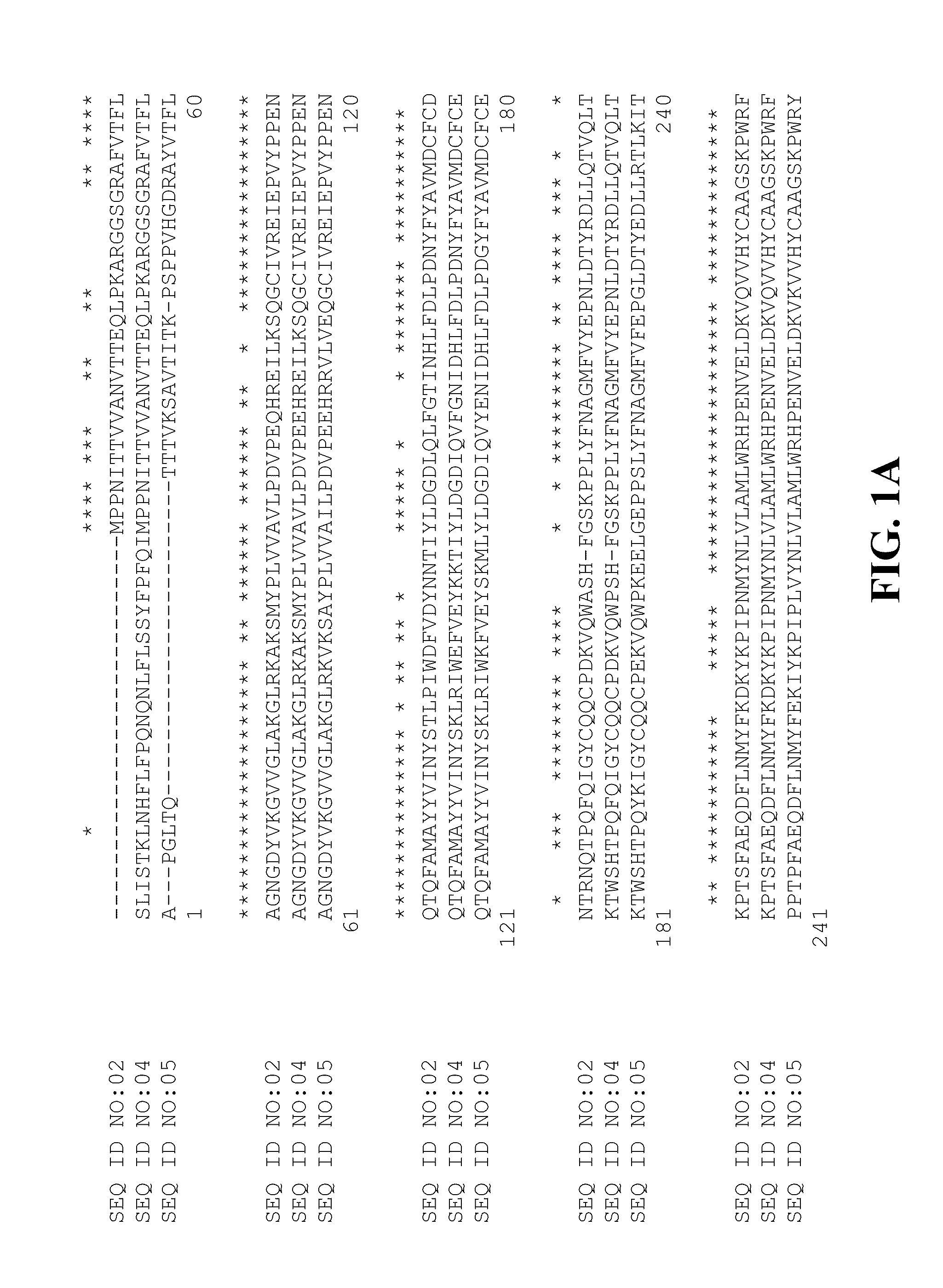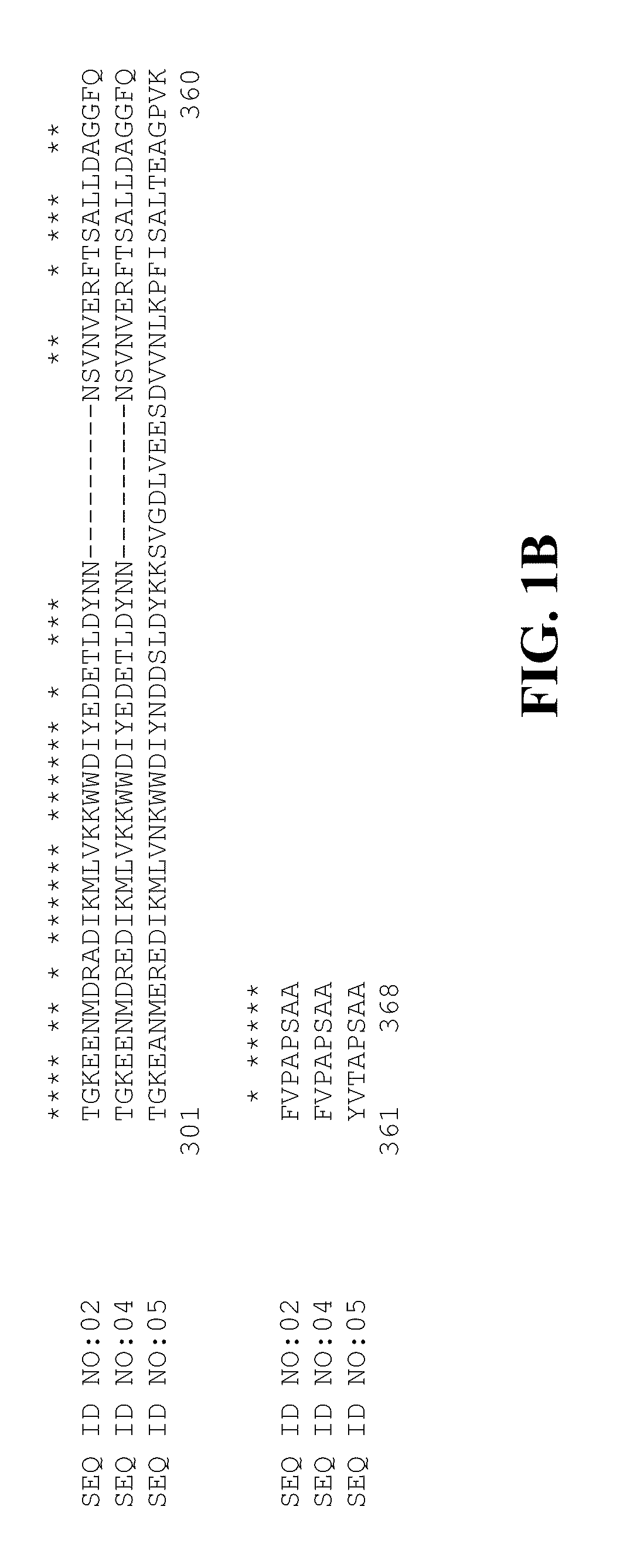Plant raffinose saccharide biosynthetic enzymes
a raffinose saccharide and biosynthetic enzyme technology, applied in the field of plant molecular biology, can solve the problems of severely restricting the use of leguminous plants in animal, particularly human, diet, and legume us
- Summary
- Abstract
- Description
- Claims
- Application Information
AI Technical Summary
Benefits of technology
Problems solved by technology
Method used
Image
Examples
example 1
Composition of cDNA Libraries; Isolation and Sequencing of cDNA Clones
[0078]A cDNA library representing mRNAs from soybean (Glycine max) tissue was prepared. The characteristics of the library are described below.
TABLE 2cDNA Libraries from SoybeanLibraryTissueCloneses4dSoybean Embryogenic Suspensionses4d.pk0017.b84 Days After Subculture
[0079]cDNA libraries may be prepared by any one of many methods available. For example, the cDNAs may be introduced into plasmid vectors by first preparing the cDNA libraries in Uni-ZAP™ XR vectors according to the manufacturer's protocol (Stratagene Cloning Systems, La Jolla, Calif.). The Uni-ZAP™ XR libraries are converted into plasmid libraries according to the protocol provided by Stratagene. Upon conversion, cDNA inserts will be contained in the plasmid vector pBluescript. In addition, the cDNAs may be introduced directly into precut Bluescript II SK(+) vectors (Stratagene) using T4 DNA ligase (New England Biolabs), followed by transfection into ...
example 2
Identification of cDNA Clones
[0084]cDNA clones encoding galactinol synthase were identified by conducting BLAST (Basic Local Alignment Search Tool; Altschul et al. (1993) J. Mol. Biol. 215:403-410; see also www.ncbi.nlm.nih.gov / BLAST / ) searches for similarity to sequences contained in the BLAST “nr” database (comprising all non-redundant GenBank CDS translations, sequences derived from the 3-dimensional structure Brookhaven Protein Data Bank, the last major release of the SWISS-PROT protein sequence database, EMBL, and DDBJ databases). The cDNA sequences obtained in Example 1 were analyzed for similarity to all publicly available DNA sequences contained in the “nr” database using the BLASTN algorithm provided by the National Center for Biotechnology Information (NCBI). The DNA sequences were translated in all reading frames and compared for similarity to all publicly available protein sequences contained in the “nr” database using the BLASTX algorithm (Gish and States (1993) Nat. Ge...
example 3
Characterization of cDNA Clones Encoding Galactinol Synthase
[0086]The BLASTX search using the EST sequences from the clone listed in Table 3 revealed similarity of the polypeptides encoded by the cDNA to galactinol synthase from Brassica napus (NCBI GenBank Identifier (GI) No. 4588376). Shown in Table 3 are the BLAST results for individual ESTs (“EST”), the sequences of the entire cDNA inserts comprising the indicated cDNA clones (“FIS”), the sequences of contigs assembled from two or more ESTs (“Contig”), sequences of contigs assembled from an FIS and one or more ESTs (“Contig*”), or sequences encoding an entire protein derived from an FIS, a contig, or an FIS and PCR (“CGS”):
TABLE 3BLAST Results for Sequences Encoding PolypeptidesHomologous to Galactinol SynthaseBLASTpLog ScoreNCBI GI CloneStatusNo. 4588376ses4d.pk0017.b8 (FIS)CGS159.00(SEQ ID NO: 1)ses4d.pk0017.b8 (FIS)CGS149.00(SEQ ID NO: 3)
[0087]SEQ ID NO: 1 was previously presented in U.S. Provisional Application No. 60 / 196,55...
PUM
| Property | Measurement | Unit |
|---|---|---|
| temperature | aaaaa | aaaaa |
| temperature | aaaaa | aaaaa |
| temperature | aaaaa | aaaaa |
Abstract
Description
Claims
Application Information
 Login to View More
Login to View More - R&D
- Intellectual Property
- Life Sciences
- Materials
- Tech Scout
- Unparalleled Data Quality
- Higher Quality Content
- 60% Fewer Hallucinations
Browse by: Latest US Patents, China's latest patents, Technical Efficacy Thesaurus, Application Domain, Technology Topic, Popular Technical Reports.
© 2025 PatSnap. All rights reserved.Legal|Privacy policy|Modern Slavery Act Transparency Statement|Sitemap|About US| Contact US: help@patsnap.com


